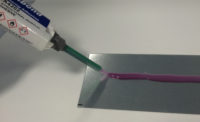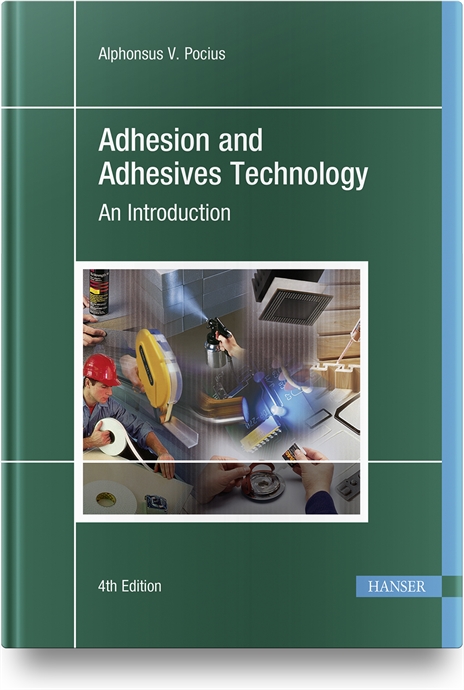Dispensing a one-part adhesive is easy. You only have to worry about the viscosity of the material, the flow rate, and how you want the material to be applied to the part.
Dispensing a two-part adhesive is another kettle of fish. Now you have two viscosities and two flow rates to think about, and you also have to be concerned with how easily the two materials will blend. You have to make sure the resin and the catalyst are metered in the correct ratio. And, you must ensure they are adequately mixed.
For example, automakers use a two-part urethane adhesive to bond the windshield to the car body. The resin is a paste with the consistency of peanut butter. The catalyst is just a little thicker than water. The two parts are mixed at a ratio of 50-to-1.
“You have to use one machine to dispense the resin and a completely different machine to dispense the catalyst,” says David Mandeville, director of marketing at Sealant Equipment & Engineering Inc. “Now, put those two machines together and try to make it work in a high-volume operation. That’s a challenge!”
Fortunately for automakers and assemblers of all sorts, suppliers of dispensing technology have developed a variety of equipment to meet challenges just like that.
The Right Ratio
The biggest challenge of dispensing two-part adhesives is staying “on ratio.” Two-part adhesives can be dispensed in ratios ranging from 1-to-1 to 50-to-1 or even higher. Adhesives that are off-ratio may not cure properly. They may not even cure at all.
Some materials, such as construction adhesives, are formulated for low-tech dispensing equipment. They can be off-ratio by as much as 10 percent to 20 percent and still provide a good bond. Other materials are less forgiving.
Most two-part adhesives must be metered to within 2 percent to 7 percent of the specified mix ratio. “As the dispense volume gets smaller and the mix ratio gets wider, the tolerance decreases to ±1 percent,” says Mandeville.
One way to improve mix-ratio accuracy is to degas the material prior to metering, says Brian Hamilton, a service technician with Scheugenpflug Inc. Because the resin and catalyst are metered volumetrically, trapped air bubbles, even microscopic ones, can throw off the mix ratio.
As a result, dispensing equipment suppliers recommend pulling a vacuum on the feed tanks for parts A and B. In some cases, heating the resin will reduce its viscosity and make it easier to degas. Stirring the material with a motorized agitator also aids with degassing—and it helps keep fillers in suspension.
“If the resin has air in it, it’s going to be spongy,” explains Don Leone, director of sales and marketing at Ashby Cross Co. “It’s going to compress a little before it moves out through the static mixer, and you’re going to have a phasing condition with the catalyst. The two materials won’t come out at the same time, and you’ll be off ratio.”
Assemblers have numerous options for metering the two components. There are fixed and variable ratio systems. There are pneumatic, hydraulic and servo-driven systems. There are piston pumps, gear pumps and positive displacement systems. Which to choose depends on the material and the application.
“The biggest challenge in dispensing two-part adhesives is that there are so many different types and variations in chemistries,” says Stephen Kohnle, vice president of sales and marketing at Fisnar Inc. “There are different ratios, viscosities and specific gravities. So the machines to dispense these materials have to be built specifically for their particular chemical properties.”
For example, gear pump metering systems have an advantage in that they’re electrically driven. The flow rate can be adjusted by varying the speed of the motor, and it’s not necessary to bleed air from the system prior to dispensing. They are best for unfilled materials with viscosities under 20,000 centipoise.
“A gear pump metering system is ideal for applications that need a variable flow rate,” says Leone. “Our gear pumps are made to tolerances in the 10 to 12 micron range. That gives you very precise metering, but you can’t run fillers through them.”
Piston pumps are more rugged and are better for handling thick, filled materials. They are typically fixed-ratio systems.
For example, in Scheugenpflug’s piston metering system, the resin and catalyst are metered via precision cylinders with highly polished interior surfaces, says Hamilton. Each cylinder is sized to match the mix ratio and volume to be dispensed. Thus, if the adhesive has a mix ratio of 2-to-1, the cylinder for the resin will be twice as large as the cylinder holding the catalyst.
Under pressure, each part is forced into its cylinder, pushing up a piston inside. When sensors inside the cylinder indicate that the required volume has been reached, a stepper motor drives down the piston, forcing the material out to the valve and mixer.
The disadvantage of piston-metering systems is that changing the mix ratio means changing the cylinder and piston assembly.
The latest technology for meter-mix equipment uses flow meters, fluid regulators and electronic controls to provide highly accurate proportioning in a variable-ratio system. For example, the new ExactaBlend system from Graco Inc. can accommodate mix ratios from 1-to-1 to 14-to-1 by weight. The mix ratio is entered digitally via a touch-pad control panel.
The system electronically monitors the flow rate of the resin and automatically adjusts the flow rate of the catalyst to achieve on-ratio metering. The machine automatically shuts down if off-ratio conditions occur, says Michael Cryer, product marketing manager at Graco.
Optional data reporting provides engineers with information on material usage, flow rate, alarm events and mix ratio.
Valve Options
Sitting between the metering system and the mixer is a valve. Here, too, assemblers have numerous options, ranging from a simple manually operated ball valve to pneumatically actuated valves for automated equipment.
For example, the Series 400 from Nordson EFD is a pneumatic valve with Teflon seals. Its cylinder retracts to open the valve and moves forward to close it. The valve body can be made from aluminum or 303 stainless steel. It can be equipped for manual, stationary or robotic operation.
Four manifolds are available:
- 1-to-1.
- Wide ratio.
- High-flow, 1-to-1.
- High-flow, wide ratio.
“The high-flow manifold is recommended for mixers 3/8 inch in diameter or larger,” says Anthony Martucci, a product line manager at Nordson EFD. “The wide-ratio manifold is recommended when the effective mix ratio is greater than 7-to-1.”
If cross-contamination occurs, the manifold can be removed and cleaned without disassembling the valve body.
EFD’s Series 450 valve is similar to the Series 400, except that the cylinder moves forward to open the valve and retracts to close it.
“When the cylinder retracts, it sucks back some of the material, so you don’t get drooling or stringing,” says Martucci.
The Right Mix
Mixing the resin and catalyst thoroughly is just as important as metering the materials in the right ratio. Assemblers have a choice between disposable static mixers made from plastic and reusable dynamic mixers made from steel.
Static mixers can be round or square and come in a range of lengths and widths to accommodate different flow rates and mixing needs. Because of their higher strength, round mixers are preferred for automated meter-mix equipment, says Martucci. The walls on square mixers can bulge in high-pressure applications, enabling material to bypass the mixing elements.
Square mixers are preferred for cartridge dispensing applications. They don’t need to be as long as round mixers to do the same amount of mixing, and they produce less back pressure on the material, says Martucci.
Round or square, mixers can be equipped with tips, such as needles, ribbon nozzles or even atomizers, to achieve a specific dispensing pattern. Many dispensing equipment suppliers will customize mixers to suit specific applications.
“We have a customer that assembles headlights. They needed to dispense adhesive into a very small groove with our mixer, but the geometry wouldn’t permit that,” Martucci recalls. “We molded a mixer with a special outlet so it could get into that groove.”
Ashby Cross has just introduced the Dyna-Stat dispensing valve for low and medium viscosity two-part adhesives. The valve is unique in that it provides dynamic mixing with disposable plastic mix chambers. This eliminates the need to clean steel dynamic mixers with solvents. The valve provides high-shear mixing for hard-to-mix materials such as polyurethanes.
Two models are available: one driven by a servomotor, the other by an air motor. The former provides precise, repeatable control over mixing speed regardless of material viscosity. The maximum mixing speed is 5,000 rpm. With the latter, mixer speed is determined by air pressure.
Electric or pneumatic, the valve can be retrofit to most metering systems. Four mixer sizes are available to match most applications.
Regardless of what type of mixer is used, assemblers are well-advised to regularly monitor how well the adhesive is being mixed, says Mandeville. Depending on the material and the machine, assemblers might check the mix once per shift, once per day or once per week.
It’s also a good idea to check the mixer regularly for signs that cured adhesive is occluding the flow of material. In fact, many meter-mix machines let engineers set up automatic purge cycles based on the cure time of the adhesive. For example, if the adhesive cures in an hour, engineers can program the machine to run a fresh shot of adhesive through the mixer if it hasn’t dispensed any material for, say, 30 minutes.
The volume of the purge shot only needs to equal the volume of the mixer. Of course, engineers will have to weigh the cost of wasted adhesive against the cost of a disposable mixer.













